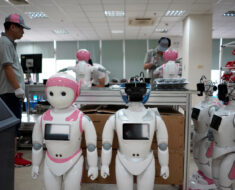
The food service industry has witnessed a gradual shift towards automation, with robots increasingly taking over tasks traditionally performed by humans. From cooking and food preparation to customer service and delivery, these technological advancements are reshaping the landscape of the industry. This article explores the growing trend of robots replacing humans in the food service sector, supported by relevant data, and delves into the implications for both businesses and consumers.
Robots are making their presence felt in various aspects of the food service industry. For instance, automated cooking systems are capable of preparing meals with precision and consistency, minimizing the risk of human error. Additionally, robotic arms and machines can handle food assembly, reducing the need for human intervention and improving efficiency. The integration of robotics and artificial intelligence has resulted in streamlined operations and improved productivity for many food establishments.
The adoption of robots in the food service industry is driven by several factors. One primary motivation is cost reduction. Robots offer long-term savings by eliminating the need for a large workforce and reducing labor-related expenses. According to a report by the McKinsey Global Institute, automation technologies could potentially save the food service industry up to $300 billion annually by 2030. This cost efficiency allows businesses to allocate resources to other areas, such as enhancing customer experiences or investing in innovation.
Another factor contributing to the rise of robots in the food service industry is the increasing demand for contactless experiences, particularly in the wake of the COVID-19 pandemic. Robots can minimize human contact and reduce the risk of transmission, providing a safe and hygienic environment for both employees and customers. This trend has led to the implementation of robotic solutions for tasks like order taking, table service, and even food delivery, ensuring a seamless and contact-free experience.
However, the growing presence of robots in the food service industry raises questions about the impact on employment. While automation may lead to job displacement for some workers, it also presents opportunities for up-skilling and retraining. As robots take over repetitive and labor-intensive tasks, human employees can focus on roles that require creativity, problem-solving, and interpersonal skills. It is crucial for businesses and policymakers to address the potential social and economic implications of automation and ensure a smooth transition for affected workers.
Furthermore, the integration of robots in the food service industry can enhance overall operational efficiency and customer experiences. Robots can work tirelessly without fatigue, ensuring faster service and reducing wait times. They also have the potential to improve order accuracy, reduce food waste, and enable customized experiences through personalized recommendations and preferences. These benefits can lead to higher customer satisfaction and loyalty, ultimately driving business growth.
Robots are gradually replacing humans in various aspects of the food service industry, transforming the way businesses operate and interact with customers. While automation offers cost savings, efficiency, and contactless experiences, it also raises concerns about employment and workforce implications. Striking a balance between automation and human labor is essential to harness the full potential of technological advancements while ensuring a positive impact on both businesses and consumers.
Dil Bole Oberoi





